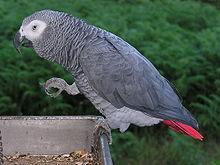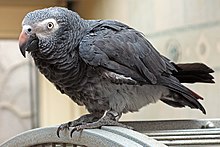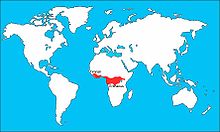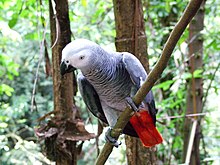
Just Push Play>
Hi Everybody!
Please come in and find a comfortable chair. To those of You returning to this site, Thank You! To those of You tuning in for the first time, Welcome. This Google Blog was created as an informal gathering of Nature Lovers around the World. We are United in our love for Nature and our Earth regardless of where we physically reside on the Earth.
Each Blog Page in this Collection (over 100 now) is different, so you may return at anytime to see other pages! Basically, we look at topics or ideas that have something to do withNature- Mother Earth Nature, Father Space Nature and Human Nature. Please add ideas for topics in comment boxes and I will check it out. Sharing knowledge is the best thing we can do for each other. Tonight, we are looking at Bird Nature (African Grey Parrots) in relation to Human Nature (Researchers, trappers, pet trade, pet owner).
The African Grey Parrot is a wonderful bird as you will see in the video lineup. The first 3 vids are of the Parrots in the Wild, where they live in Nature. They briefly explain why these birds are disappearing and may soon be gone from the Earth Forever.
Next, I chose 2 famous African Grey Parrots, Einstein and Alex. (There are more in depth vids on these birds on You Tube, I chose the shorter ones here). The women who trained these birds truly loved them and bonded with another species. You will see this is true. These 2 birds had a wonderful life and taught us so much about communicating with another species. The last parrot video is about what we have learned from birds about human speech. (Very interesting). ENJOY!

Baby African Gray Parrot
African Grey Parrot
The African Grey Parrot (Psittacus erithacus), also known as the Grey Parrot, is a medium-sized parrotfound in the primary and secondary rainforest of West and Central Africa. Experts regard it as one of the most intelligent birds. They feed primarily on palm nuts, seeds, fruits, leafy matter, but have been observed eating snails. Their overall gentle nature and their inclination and ability to mimic speech have made them popular pets. This has led many to be captured from the wild and sold into the pet trade. The African Grey Parrot is listed on CITES appendix II, which restricts trade of wild caught species, because wild populations can not sustain trapping for the pet trade. As a pet, they must be kept entertained and busy with a person or toy or they may become stressed and begin self-destructive behaviour.| African Grey Parrot | |
|---|---|
 | |
| Congo African Grey Parrot | |
 | |
| Timneh African Grey Parrot | |
| Conservation status | |
| Scientific classification | |
|---|---|
| Kingdom: | Animalia |
| Phylum: | Chordata |
| Class: | Aves |
| Order: | Psittaciformes |
| Superfamily: | Psittacoidae |
| Family: | Psittacidae |
| Subfamily: | Psittacinae |
| Genus: | Psittacus |
| Species: | P. erithacus |
| Subspecies | |
| |
 | |
| Ranges shown by the red areas | |

A one day old Congo African Grey Parrot chick that was hatched in an incubator
Status and conservation
Mimicry and intelligence

http://en.wikipedia.org/wiki/African_Grey_Parrot
Mutations
- Albino (no pigment)
- Lutino (yellow pigment)
- Incomplete Ino (mostly white, but with small percentage of melanin)
- Grizzles (soft pinkish scalloping found in its feathers)
- Blues (white pigment in the tail)
- Parino (very light scalloping found in its feathers)
This is a short documentary about bird brains, Just Push Play>
This concludes our look at the African Grey Parrot. The ideas presented here tonight give us all much to think about. I am just one old lady who owns a Bird Sanctuary. I have a wildlife habitat and wild birds, no cages. Personally, I regret that any bird has to be in any cage for any reason anywhere on Earth. I will not buy anything from pet stores. I encourage Everyone to save these birds and NOT buy anymore Parrots to put in cages.
So Goodnight, my friends. I leave you with one more great performance with the Beautiful Nature of Africa!
http://www.google.com/imgres?imgurl=http://www.avianweb.com/images/birds/AfricanGreyParrot2.jpg&imgrefurl=http://www.avianweb.com/africangreys.htm&h=389&w=467&sz=196&tbnid=4K_g8_rqbbuWDM:&tbnh=92&tbnw=111&zoom=1&docid=ItTh65PggbnQZM&hl=en&sa=X&ei=VcaVT-agCMOdgwf36dCdCA&ved=0CFgQ9QEwDg&dur=3773

http://www.petworkssanantonio.com/birds-for-sale.html

Baby African Gray Parrot

http://en.wikipedia.org/wiki/African_Grey_Parrot

....this is brendasue signing off from Rainbow Creek.
See You next time!
O+O



Hallo brendasue !
ReplyDeleteIch wünsche dir von ganzen Herzen alles Gute !
Ganz liebe Grüße schicke ich dir aus Hamburg von
Gisela !
Buy parrots online | Parrots for sale | Parrot and Eggs Breeder's
ReplyDeleteContact Us : birdsfarmsales@gmail.com | Call/ Text +1 646-535-7719
We are license to export parrots and eggs to USA, Europe, Asia, United Arab Emirates, Oceania, Middle East. Our parrots are transported in secured cages and live parrots boxes. We also have available fertile parrots eggs for sale.
Now available in stock are the following live parrots and birds for sale. We also have chicks from 1 day old up to 60 days old available in stock. Our parrots are free from the bird flu and vet checked. They are tamed and hand raised. They can serve as good pets and companions.
Contact Us:
Email us :birdsfarmsales@gmail.com
Call/ Text +1 646-535-7719
Buy African Grey Parrots online
Buy Blue & Gold Macaw online,
Buy Hyacinth Macaws online,
Buy Cockatoo Parrots online,
Buy Toucans online,
Buy Caique Parrots online,
Buy Conures online,
Buy Falcon Birds online,
Buy Amazon parrots online,
Buy African Grey parrot eggs
Buy Hyacinth macaw eggs,
Buy Black palm cockatoo eggs,
Buy Blue and gold macaw eggs,
Buy Citron cockatoo eggs,
Buy Gang gang cockatoo eggs,
Buy Goffin cockatoo eggs,
Buy Green wing macaw eggs,
Buy Harlequin macaw eggs,
Buy Hyacinth macaw eggs,
Buy Major Mitchell cockatoo eggs,
Buy Rose breasted cockatoo eggs,
Buy Scarlet macaw eggs,
Buy Umbrella Cockatoo eggs,
Buy Scarlet Macaw eggs,
Buy Sollomons Island Eclectus eggs,
Buy Amazon Parrot eggs,
Buy Finches eggs ,
Buy Falcons eggs ,
Buy Canaries eggs,
Buy Conures eggs,
Buy Electus Parrot eggs,
Buy Senegal Parrot eggs,
Buy Parakeets eggs,
Buy Cockatiels eggs,
Buy Hawk Headed Parrots,
Buy Toco Toucan eggs,
Buy Conures eggs,
All our eggs are collected from very healthy birds in our Aviary , candle tested and 100% confirmed fertile for hatching healthy babies . We are now taking orders from those who are interested in raising up their own baby birds from the eggs stage.
Its fun hatching your own baby(ies) from eggs and we will assist you in any way to hatch out your birds successfully.
Contact Us:
Email us :birdsfarmsales@gmail.com
Call/ Text +1 646-535-7719